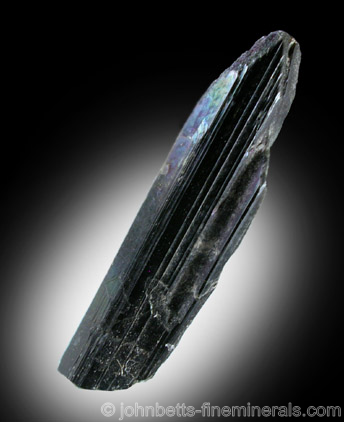The Mineral aegirine

Aegirine is a member of the pyroxene group, and forms a series with the mineral Augite. It is well known for its long slender crystals with very distinctive terminations, and some of the more lustrous forms of this mineral are true classics. Aegirine was named by Norweigan mineralogist Hans Morten Thrane Esmark (1801–1882). Esmark named this mineral after Aegir, a mythical Norse sea god, in recognition of the discovery of Aegirine near the sea.
Chemical Formula
NaFeSi2O6
Color
Black, brown, dark green, reddish black
Crystal System
Monoclinic
Properties
Streak
Light gray |
Hardness
6 - 6.5 |
Transparency
Opaque. Translucent in thin splinters. |
Specific Gravity
3.5 - 3.6 |
Luster
Vitreous |
Cleavage
1,2; Prismatic at cleavage angles of 87º and 93º (characteristic of minerals in the pyroxene group).
May also exhibit parting in one direction. |
Fracture
Uneven, splintery |
Tenacity
Brittle |
Uses
The steep, prismatic, well-shaped specimens are valued by collectors.
Noteworthy Localities
Aegirine comes from Norway at Ovre Eiker and Kongsberg in Buskerud; and at Langesunfjord in Telemark and Vestfold. Other well-know Aegirine occurrences are the Khibiny Massif in the Kola Peninsula of Russia; Narssarssuk Greenland; and Pocos de Caldas, Minas Gerais, Brazil. Some of the most outstanding crystals of Aegirine, in lustrous slender crystals often perched on a matrix come from Mt. Malosa, Zomba District, Malawi.
In the U.S., the premier Aegirine locality is Magnet Cove, Garland Co., Arkansas, where slender crystals can be found crisscrossing in a light colored matrix. In Canada, outstanding specimens, often associated with rare minerals, comes from the quarries at Mont St. Hilaire, Quebec. Also recently producing fine specimens is the nearby Demix-Varennes quarry in Varennes, Quebec.
Distingushing Similar Minerals
Augite - Lacks steep pyramidal crystals.
Tourmaline - Lacks steep pyramidal crystals, harder.
Arfvedsonite - Can be very difficult to distinguish, though lacks steep pyramidal crystals.